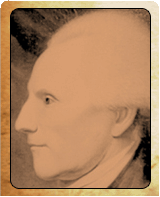
Richard Howe, 1st Earl Howe KG (8 March 1726 - 5 August 1799) was a British admiral, notable in particular for his service during the American War of Independence and French Revolutionary Wars.
Early Career
Howe was born in London, the second son of Emanuel Scrope Howe, 2nd Viscount Howe, who died as governor of Barbados in March 1735, and of Charlotte, a daughter of Baroness von Kielmansegg, afterwards Countess of Darlington, the half-sister of King George I which does much to explain his early rise in the navy. Richard Howe entered the navy in the Severn, one of the squadron sent into the south seas with George Anson in 1740. The Severn failed to round Cape Horn and returned home. Howe next served in the West Indies aboard Burford and was present when she was severely damaged in the unsuccessful attack on La Guayra on February 18, 1742. He was made acting-lieutenant in the West Indies in the same year, and the rank was confirmed in 1744.
During the Jacobite Rising of 1745, he commanded the sloop Baltimore in the North Sea, and was severely wounded in the head while cooperating with a frigate in an engagement with two French privateers. In 1746, he became post-captain, and commanded Triton in the West Indies. As captain of Cornwall, the flagship of Sir Charles Knowles, he was in the battle with the Spaniards off Havana on October 2, 1748. Between the War of the Austrian Succession and the Seven Years' War, Howe held commands at home and on the west coast of Africa. In 1755, he went with Edward Boscawen to North America as captain of Dunkirk, and his capture of the French Alcide was the first shot fired in the war. From then until the peace of 1763, he served in the Channel in various more or less futile expeditions against the French coast, gaining a reputation as a firm and skilful officer. On November 20, 1759, he led Hawke's fleet as captain of Magnanime in the Battle of Quiberon Bay.
After the death of his elder brother, killed near Ticonderoga on July 6, 1758, he became Viscount Howe in the Peerage of Ireland. In 1762, he was elected M.P. for Dartmouth, and held the seat until he was elevated to the House of Lords as Earl Howe in the Peerage of Great Britain. During 1763 and 1765, he was a member of the Admiralty board. From 1765 to 1770, he was treasurer of the navy. At the end of his tenure, Howe was promoted to Rear admiral, and then again, in 1775, to Vice admiral. The following year, he was appointed to the command of the North American station.
American War of Independence
At the beginning of the American Revolution, Howe was known to be sympathetic to the colonists. He had known Benjamin Franklin, who was a friend of his sister, a popular lady in London society. Howe had written to Franklin in a peacemaking effort. Because of his known sentiments, he was selected to command in America. He was joined in a commission with his brother, General Sir William Howe, head of the land forces, to attempt a reconciliation. A committee appointed by the Second Continental Congress conferred with the Howes in September 1776, but nothing came of it. The appointment of a new peace commission in 1778 offended the admiral deeply, and he resigned of his command. His resignation was reluctantly accepted by Lord Sandwich, then First Lord, but before it could take effect France declared war, and a powerful French squadron was sent to America under the Comte d'Estaing. Greatly outnumbered and forced to take a defensive stance, Howe nevertheless baffled the French admiral at Sandy Hook, and defeated d'Estaing's attempt to take Newport, Rhode Island by a fine combination of caution and calculated daring. On Admiral John Byron's arrival from England with reinforcements, Howe left his station in September 1778. Declining to serve afterwards, he cited distrust of Lord North and a lack of support during his command in America. He was further embittered by the suppression of himself and his brother as peace commissioners, as well as by attacks in the press against him by ministerial writers.
Later career and legacy
In 1782, he was created Viscount Howe of Langar, and, in 1788, Baron and Earl Howe. In June 1797, he was made a Knight of the Garter. Though he did not seek his sailors' affection, he was popular with them, for they knew him to be just. His nickname "Black Dick" was given because of his swarthy complexion, and the portrait by Thomas Gainsborough shows it was apt. Howe was buried in his family vault at St. Andrew's Church, Langar Nottinghamshire. His monument by John Flaxman is in St Paul's Cathedral.
Lord Howe was married on March 10, 1758 to Mary Hartop, the daughter of Colonel Chiverton Hartop of Welby in Leicestershire, and had two daughters. His Irish title descended to his brother, General William Howe, who died childless in 1814. The earldom and the viscountcy of the United Kingdom, being limited to male heirs, became extinct. The barony passed to his daughter, Sophia Charlotte (1762-1835), who married the Hon. Penn Assheton Curzon. Their son, Richard Curzon-Howe, succeeded his paternal grandfather as Viscount Curzon in 1820 and was created Earl Howe in 1821; he was succeeded by his son, George (1821-1876).
Four British warships have borne the name HMS Howe in his honor.
PREVIOUS: Lord Cornwallis | Admiral Lord Howe | NEXT: General Sir William Howe
